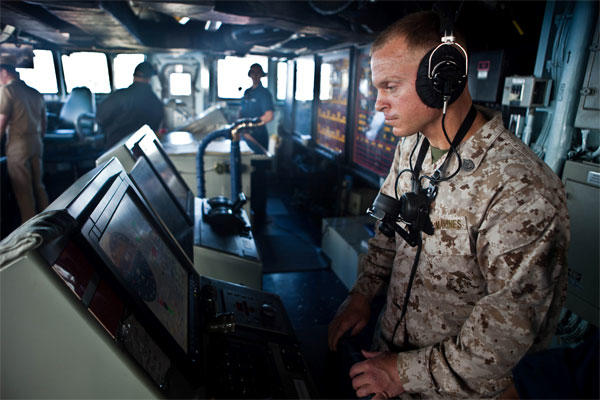USS GERMANTOWN, At Sea -- He spoke at length on plotting courses and directing a ship in the event of unknown contact. He stressed the importance of factoring in distance, weather and sea state. He spoke knowledgeably and without error as only a trained nautical expert could.
But the individual giving the speech was not a navigator; in fact, he wasn’t even a sailor.
Staff Sgt. Michael W. Burkhart, an amphibious assault vehicle section leader with Company G., Battalion Landing Team 2nd Battalion, 4th Marines, 31st Marine Expeditionary Unit, is using spare time on ship to gain a unique skill. He is learning to be a qualified helmsman for Navy vessels.
“With this qualification by the master helmsman of (USS) Germantown, I’ll be able to pilot most types of Navy ships,” said Burkhart. “I would have to spend a bit of time learning each ship’s unique procedures, but I would be able to take the helm.”
Growing up on the shores of Lake Thunderbird in Norman, Okla., Burkhart cultivated a passion for the water. Swimming and boating took up much of his adolescence, greatly influencing his decision to join the Marine Corps over the other branches.
Burkhart became an AAV operator to keep close to the waters, working nearly a decade to earn his present rank and billet. Now attached to the 31st MEU and embarked on a Navy ship, he’s taking his amphibious interests a step further.
“I wanted to know how everything worked with the ship, how it operated and what they had to do to accommodate our AAVs,” said Burkhart. “Through talking with the Sailors on the bridge, I started picking up a lot of knowledge about the ship. At the rate I was going I could be a certified helmsman before the deployment ended, so that’s what I started working toward.”
But Burkhart does not let his nautical interests interfere with his responsibilities. His Marines do not question his dedication to them or the vehicles.
“His job as a Marine takes obvious priority,” said Lance Cpl. Jose J. Aguinada, AAV operator with Co. G., BLT 2/4, 31st MEU, and native of Bronx, N.Y. “All day he’s in the well deck with us and the vehicles, but after-hours and during his personal time he’s cross-training on the bridge.”
Becoming a helmsman is not an occupation itself; it is a requirement in becoming a boatswain’s mate, a position which encompasses multiple aspects of a ship’s bridge. A helmsman must have extensive knowledge of ship operations, including procedures during emergencies and unknown contacts. It takes approximately three months to learn the knowledge expected of a helmsman. For Burkhart, it has only taken one week of solid instruction to be ready to test before a board of boatswain’s mates.
“It’s crazy, he learns something once and can relay it back a week later with no refreshment of the knowledge,” said Petty Officer 3rd Class Michael D. Matthews, boatswain’s mate with the USS Germantown and native of Bedford, Ind. “We’ve even thrown trick questions at him, but he’s answered the way an experienced helmsman would answer with correct procedures.”
Burkhart only needs more practice piloting the ship before being tested out and proven qualified. It is his hope that before the patrol of USS Germantown is over, he will be one of the few, if not the only, Marine helmsman for Navy ships.
“It’s invigorating being on the bridge and taking control of the ship,” said Burkhart. “Not only am I pursuing a personal interest, (but) I’m gaining a better understanding in the full spectrum of Marine/Navy amphibious operations and how we work together.”
The 31st MEU is embarked aboard the Bonhomme Richard Amphibious Ready Group, currently conducting exercise Talisman Saber 2013, a biennial training exercise with the Australian military designed to enhance multilateral collaboration in support of future combined operations, natural disaster, humanitarian and emergency response.
The 31st MEU is the Marine Corps’ force in readiness for the Asia Pacific region and the only continuously forward-deployed MEU.




























